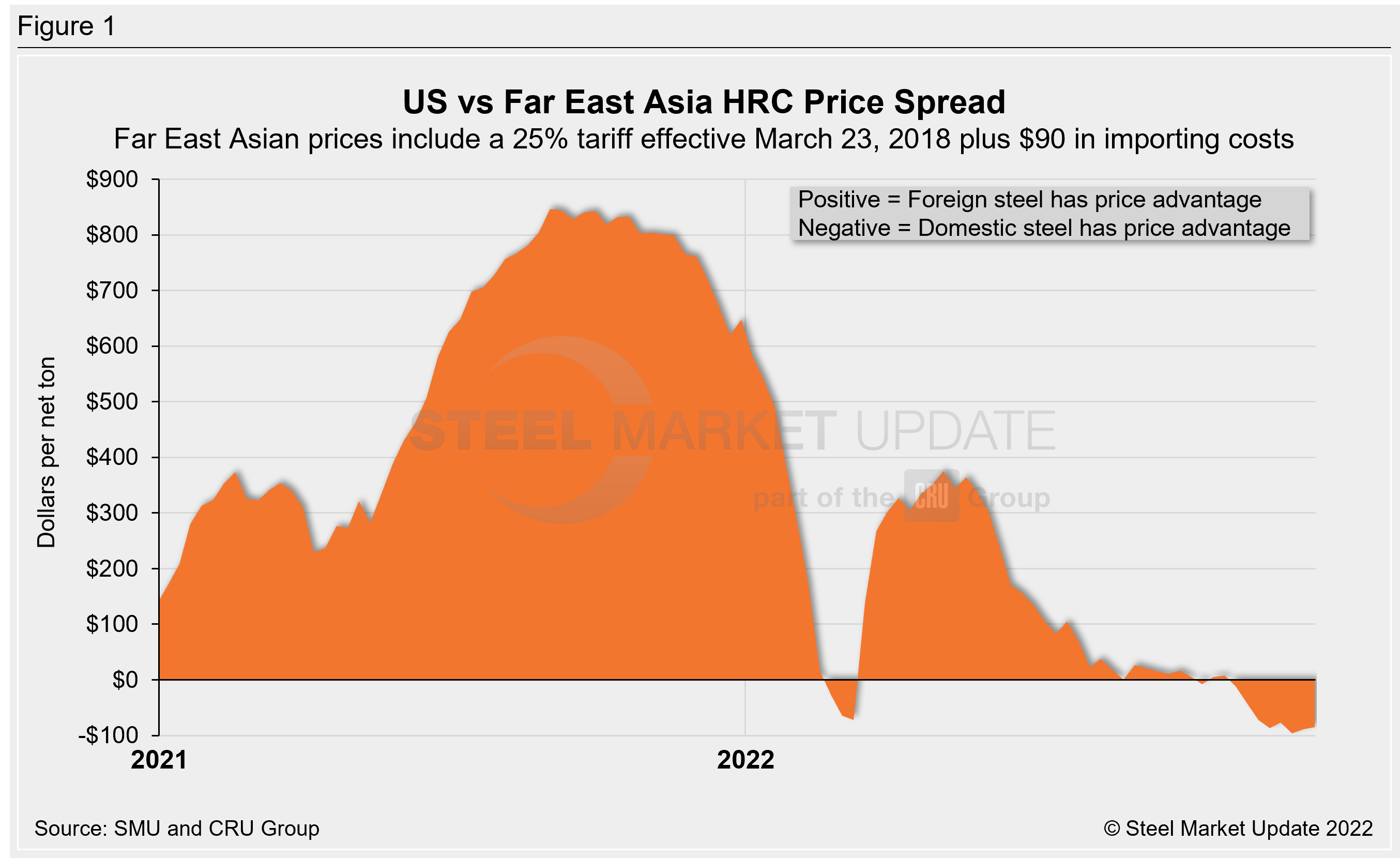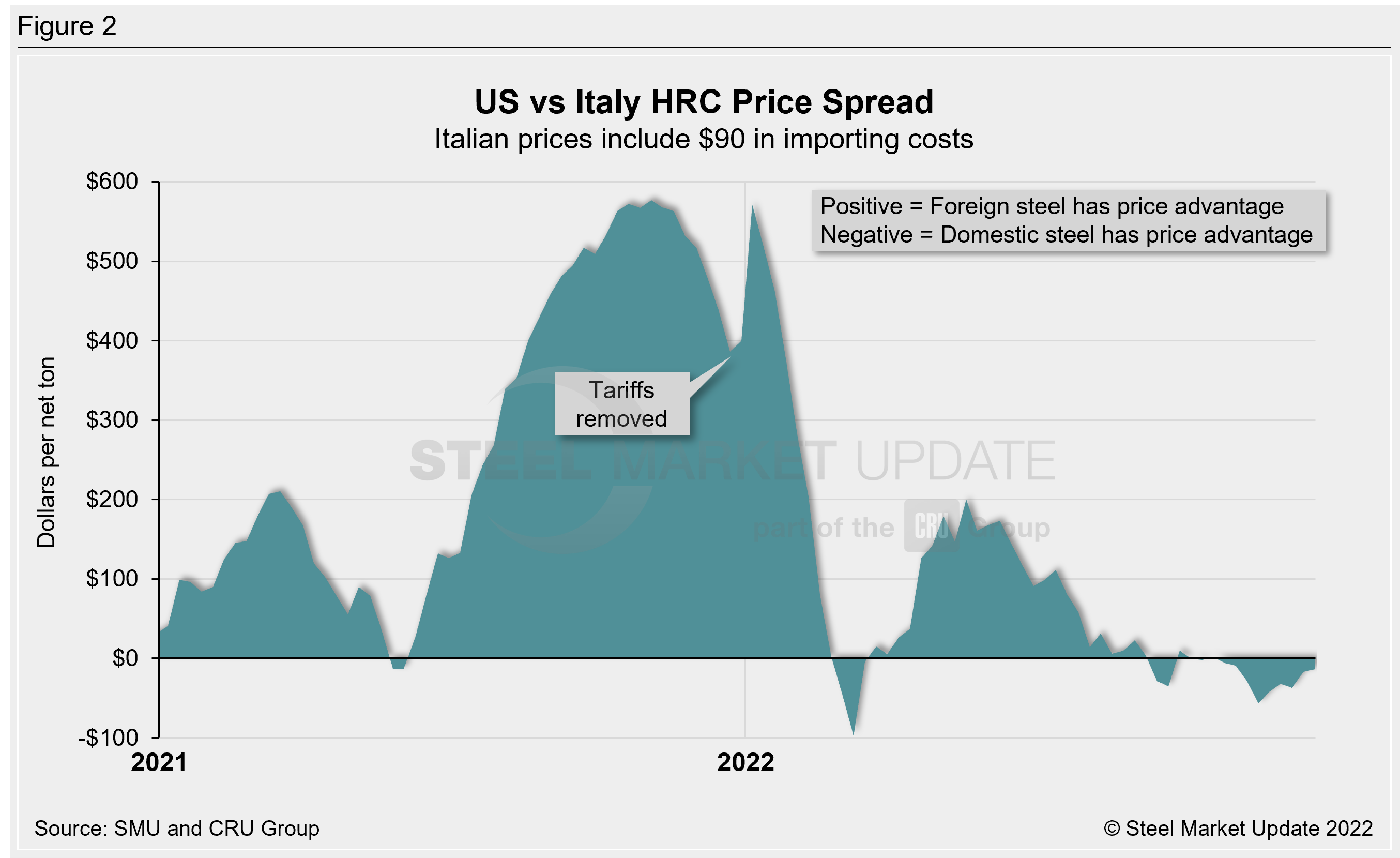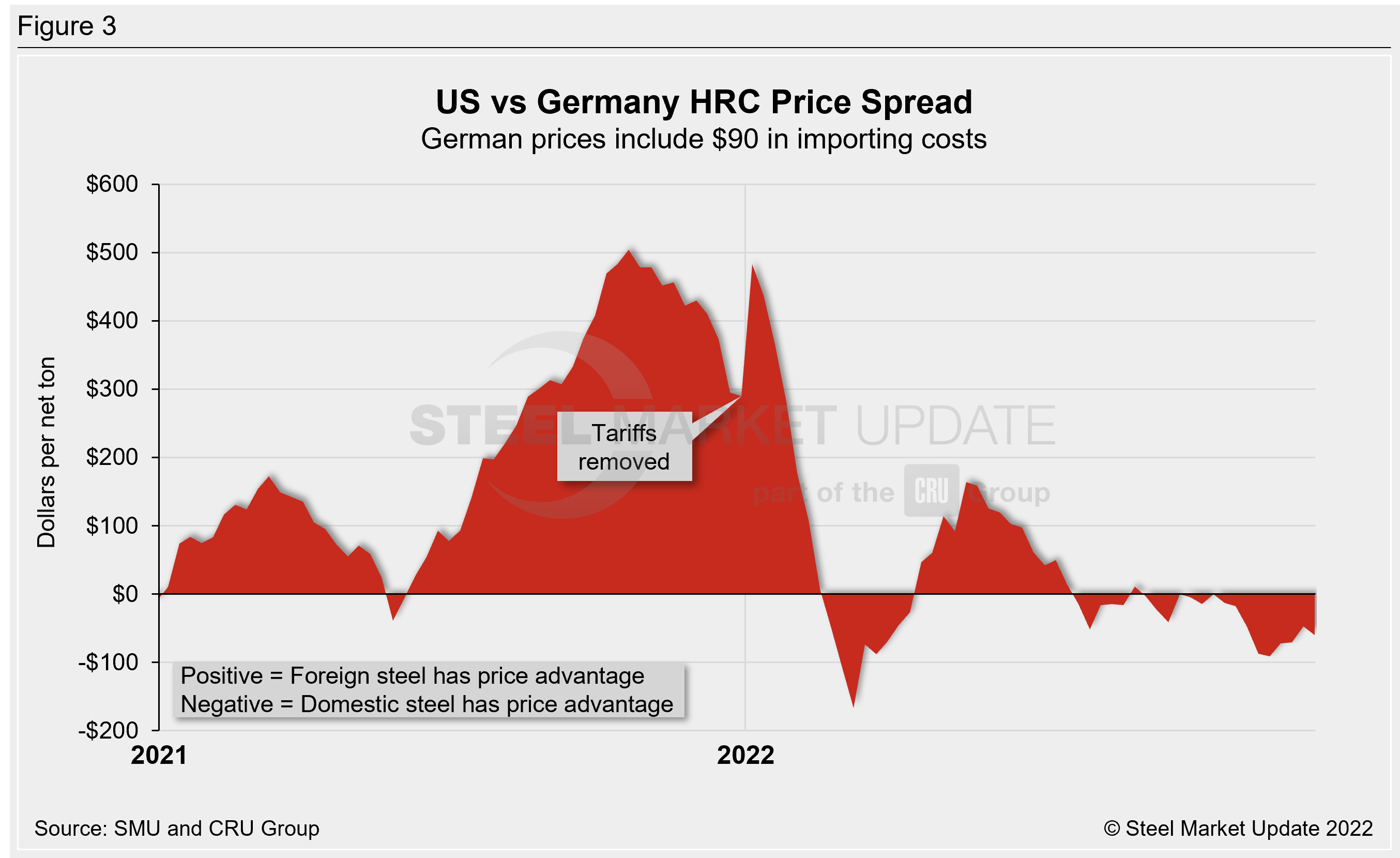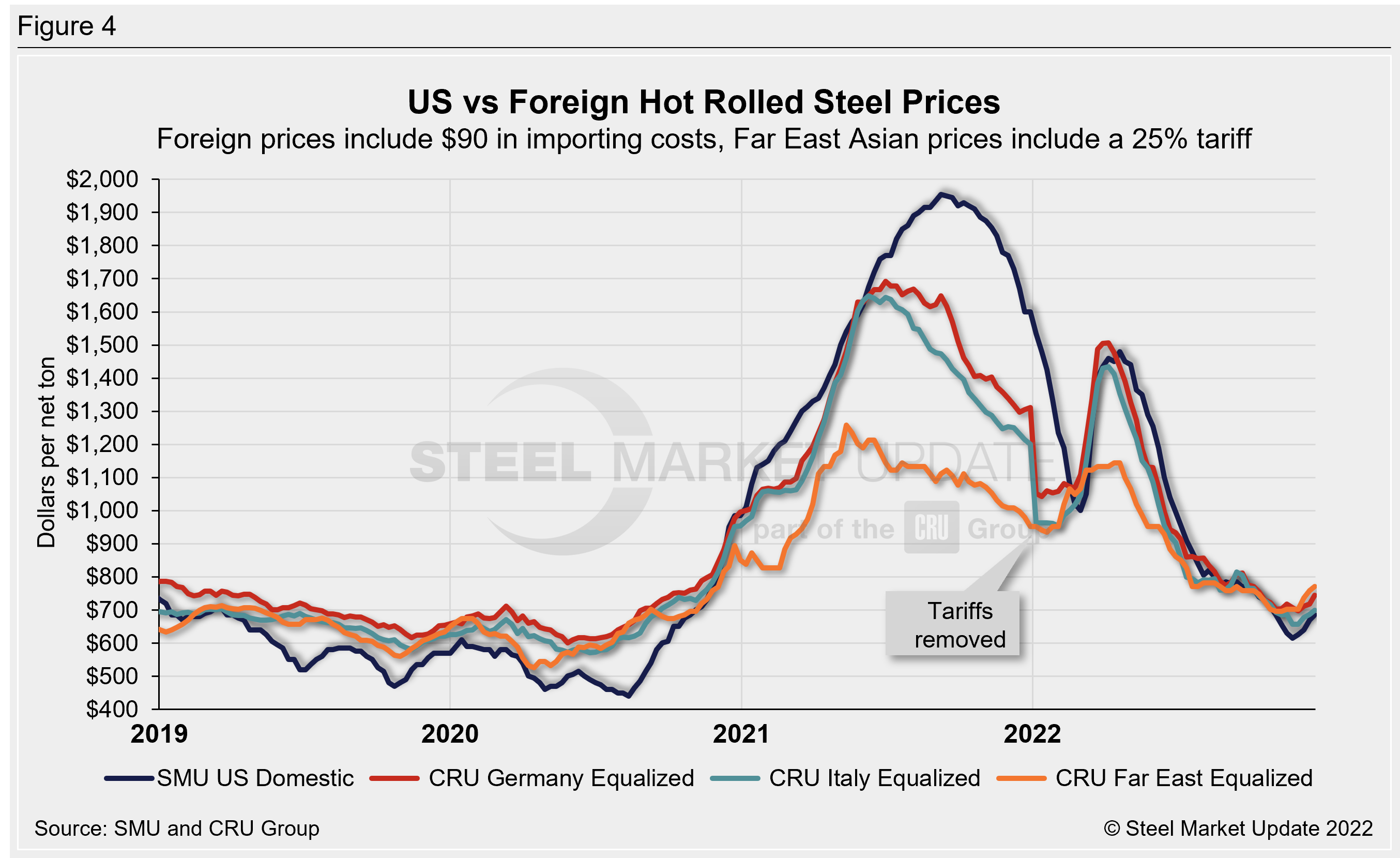Environment and Energy
Domestic Hot Rolled Prices Maintain Edge Over Imports
Written by Brett Linton
December 22, 2022
Prices of imported hot-rolled coil (HRC) remain higher than domestic steel, according to Steel Market Update’s latest foreign vs. domestic price analysis. US HRC is approximately 2–12% cheaper than foreign prices this week, after consideration of freight costs, trader margins and any applicable tariffs. This is the eighth consecutive week domestic prices have been cheaper than foreign prices for all tracked regions. HRC prices increased across the board week over week, with the average spread slightly rising from $51 per ton last week to $53 per ton this week.
![]() SMU uses the following calculation to identify the theoretical spread between foreign HRC prices (delivered to US ports) and domestic HRC prices (FOB domestic mills): Our analysis compares the SMU US HRC weekly index to the CRU HRC weekly indices for Germany, Italy, and Far East Asian ports. This is only a theoretical calculation because costs to import can vary greatly and often fluctuate, which influences the true market spread.
SMU uses the following calculation to identify the theoretical spread between foreign HRC prices (delivered to US ports) and domestic HRC prices (FOB domestic mills): Our analysis compares the SMU US HRC weekly index to the CRU HRC weekly indices for Germany, Italy, and Far East Asian ports. This is only a theoretical calculation because costs to import can vary greatly and often fluctuate, which influences the true market spread.
In consideration of freight costs, handling, and trader margin, we add $90 per ton to all foreign prices to provide an approximate “CIF US ports price” that can be compared against the SMU domestic HRC price. Buyers should use our $90-per-ton figure as a benchmark, adjusting it as necessary based on their own shipping and handling costs. If you have experience importing foreign steel and want to share your thoughts on these costs, we welcome your insight and comments: Brett@SteelMarketUpdate.com.
Far East Asian HRC (East and Southeast Ports)
As of Wednesday, Dec. 21, the CRU Far East Asian HRC price increased $9 per ton week over week to $544 per net ton ($600 per metric ton), up $54 from levels one month prior. Adding a 25% tariff and $90 per ton in estimated import costs, the delivered price of Far East Asian HRC to the US is $770 per ton. The latest SMU hot-rolled average is $685 per ton, up $15 from last week and up $70 compared to our price one month ago.
Therefore, US-produced HRC is now $85 per ton cheaper than steel imported from Far East Asia. Two weeks ago we saw a spread of $96 per ton, the largest price appeal that domestic HRC has had over Far East Asian HRC since September 2020. One month ago domestic prices held a discount of $87 per ton over foreign steel. Prior to October, Far East Asian prices had held the advantage since mid-March (the differential peaked at $375 per ton in May). The widest price advantage recorded for Far East Asian prices was just over a year ago, at $847 per ton in September 2021.

Italian HRC
Italian HRC prices increased $12 per ton week over week to $609 per net ton ($672 per metric ton) this week, $42 per ton higher than prices seen one month prior. After adding import costs, the delivered price of Italian HRC is approximately $699 per ton.
Domestic HRC is now theoretically $14 per ton cheaper than imported Italian HRC, down from $17 per ton last week. This is now the smallest spread recorded since early November. Just over one month ago we saw a spread of $57 per ton, the largest margin in favor of US prices recorded since March. The largest spread this year was $200 per ton in May when Italian prices held a considerable advantage. Before the removal of the 25% Section 232 tariff, the spread just over one year ago reached $577 per ton in November, the largest in SMU’s data history.

German HRC
CRU’s latest German HRC price increased $28 per ton week over week to $655 per net ton ($722 per metric ton), up $38 per ton compared to one month ago. After adding import costs, the delivered price of German HRC is approximately $745 per ton.
Accordingly, domestic HRC is now theoretically $60 per ton cheaper than imported German HRC, up from a spread of $47 per ton one week prior. Four weeks ago prices between these regions were $91 per ton apart (with US prices holding the advantage), the widest spread seen since March. Domestic HRC has held this price advantage for all but three weeks since late July. German HRC held the price advantage for the three months prior to that, having reached a 2022 high of $164 per ton in May. Prior to the removal of the 25% tariff, the October 2021 spread of $504 per ton was the widest in SMU’s data history.

Figure 4 compares all four price indices and highlights the effective date of the tariffs. Foreign prices are referred to as “equalized,” meaning they have been adjusted to include importing costs (and tariffs in some cases) for a like-for-like comparison against the US price.

Notes: Freight is an important part of the final determination on whether to import foreign steel or buy from a domestic mill supplier. Domestic prices are referenced as FOB the producing mill, while foreign prices are CIF the port (Houston, NOLA, Savannah, Los Angeles, Camden, etc.). Inland freight, from either a domestic mill or from the port, can dramatically impact the competitiveness of both domestic and foreign steel. When considering lead times, a buyer must take into consideration the momentum of pricing both domestically and in the world markets. In most circumstances, domestic steel will deliver faster than foreign steel ordered on the same day.
Effective Jan. 1, 2022, the traditional Section 232 tariff no longer applies to most imports from the European Union. it has been replaced by a tariff rate quota (TRQ). Therefore, the German and Italian price comparisons in this analysis no longer include a 25% tariff. SMU still includes the 25% Section 232 tariff on foreign prices from other countries. We do not include any antidumping (AD) or countervailing duties (CVD) in this analysis.
By Brett Linton, Brett@SteelMarkeUpdate.com

Brett Linton
Read more from Brett LintonLatest in Environment and Energy

Global Steel Climate Council certifies eight SDI, ASA HR products
GSCC certifies eight products from Steel Dynamics and Arkansas Steel Associates.

June energy market update
In this Premium analysis we examine North American oil and natural gas prices, drill rig activity, and crude oil stock levels. Trends in energy prices and rig counts serve as leading indicators for oil country tubular goods (OCTG) and line pipe demand.

EPA deregulation proposals win praise from steel advocates
Two industry groups are applauding two EPA proposals that would support domestic steel production.

Met coal receives critical materials status
The US Department of Energy (DOE) adds metallurgical coal to the nation’s list of Critical Materials, following its designation by US Secretary of Energy, Chris Wright’s announcement on May 22.

May energy market update
An analysis of the North American energy market in May.
